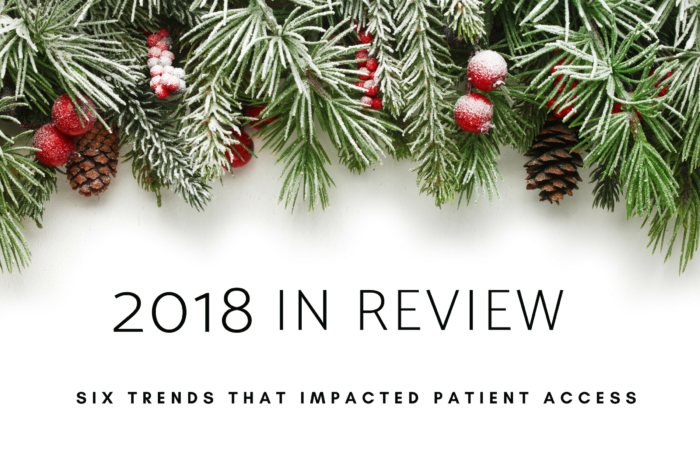Before ringing in the new year, the Institute for Patient Access takes a look back at the policy trends that shaped health care access in 2018.

1. A dirty co-pay surprise blindsided patients.
Co-pay accumulator adjustment programs presented patients with an ugly surprise at the pharmacy counter: The card that helps them afford their medication no longer counts toward their annual deductible. That forces patients to choose between paying hundreds, even thousands of dollars, for their medication – or walking away without it.
Learn more:
VIDEO: The Co-Pay Surprise
PAPER: Co-pay Accumulator Adjustment Programs
PAPER: What Can Policymakers Do to Protect Patients?
2. Efforts to lower prescription drug prices took a dangerous turn.
The cost of lowering drug prices landed squarely in the laps of one of America’s most vulnerable patient populations: Medicare beneficiaries. First, the Trump administration opened the door for step therapy use in Medicare Advantage plans. Then, the Centers for Medicare and Medicaid Services announced an experiment that could disrupt Medicare Part B and undermine access for seniors.
Learn more:
BLOG: New Step Therapy Requirements Coming to Medicare Advantage
BLOG: The Grinch Who Stole Medicare
3. Legislators woke up to non-medical switching.
In the wake of rising awareness, several state legislatures took action against non-medical switching – when health plans switch their coverage rules to drive stable patients to an insurer-preferred medication. And polling suggested that voters in other states want similar protections.
Learn more:
BLOG: Maine Delivers Patient Victory on Non-Medical Switching
BLOG: Illinois Joins Maine in Limiting Non-Medical Switching
POLL: Voters Want Policy that Limits Non-Medical Switching
4. ICER said “no” – again and again.
The Institute for Clinical and Economic Review recycled its flawed approach to health care valuation to deem a new set of drugs – from endometriosis treatments to asthma therapies – too expensive. Health plans took their cue, with CVS Health announcing it would allow plan formularies to exclude medications that didn’t meet ICER’s threshold.
Learn more:
PAPER: ICER Myth
BLOG: How ICER gets it wrong
BLOG: Patient access withers under ICER’s influence
GRAPHIC: Who has a seat at ICER’s table?
5. Biosimilars got their due.
Lower-cost biological medicines known as biosimilars took center stage, as regulators offered final guidance on biosimilar labeling and issued a Biosimilars Action Plan to encourage competition among the complex drugs.
Learn more:
FAST FACTS: Biosimilars Policy in 2018 & Beyond
VIDEO: National Policy & Advocacy Summit on Biologics and Biosimilars
6. America met “The Middleman.”
Pharmacy benefit managers registered on the radar of more Americans, from average patients to the president of the United States. With increased awareness came interest – and outrage – at the role these middleman can have on patients’ out-of-pocket medication costs.
Learn more:
VIDEO: The Middleman
BLOG: Lower Drug Prices Aren’t Helping Patients
PAPER: Protecting Access to Diabetes Care
Rejoin the Institute for Patient Access Policy Blog on January 3 to follow these – and other – patient access issues in 2019. Happy holidays!

